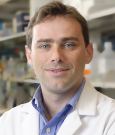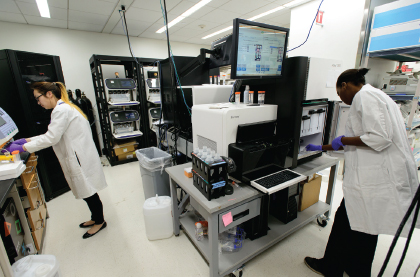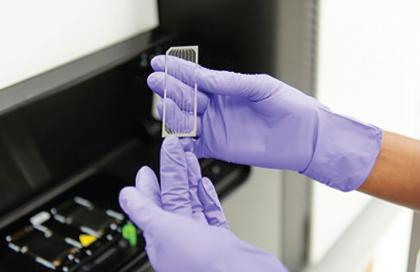In 2014, Memorial Sloan Kettering Cancer Center (MSKCC) in New York opened the Marie-Josée and Henry R. Kravis Center for Molecular Oncology with the sole purpose of expediting the translation of novel molecular discoveries into clinical innovations to turn the goal of precision oncology care into a reality. Occupying two floors in the cancer center’s research building, the molecular oncology center houses an integrated genomics operation and a next-generation sequencing lab. The genomics operation includes a multidisciplinary team of clinicians, pathologists, cancer biologists, and bioinformaticians. The next-generation sequencing lab performs retrospective analysis of tumor samples from patients enrolled in clinical studies to determine response to therapy. The Center for Molecular Oncology is also coordinating closely with the Molecular Diagnostic Service in the Department of Pathology, which is tasked with prospectively sequencing a patient’s tumor for enrollment in a clinical study or administration of a targeted therapy.
Currently, the Center for Molecular Oncology is limiting prospective genomic sequencing to patients with metastatic solid tumors to potentially match them to clinical studies. Eventually, the center plans to sequence the tumors of all patients with cancer, including blood cancers, in both the primary and metastatic disease settings. To date, the center has sequenced the tumors of more than 4,000 patients and plans to increase that number to 10,000 patients a year.
“We will learn a lot more from the clinical sequencing we are doing once we are able to sequence the tumors of a much larger number of patients, and we will know which of the significant mutations that have been discovered and linked to cancer biology are also predictive or prognostic clinically,” said Michael F. Berger, PhD, Associate Director of the Center for Molecular Oncology.
In addition to identifying the biologically relevant mutations in each cancer type and determining the most likely effective course of therapy, a primary goal of the Center for Molecular Oncology is to facilitate patient enrollment into basket studies, which are clinical trials based on a specific cancer gene or mutation rather than on a specific cancer type. MSKCC’s basket studies are investigating whether patients with many different disease types, such as ovarian, colorectal, and lung cancers, but whose tumors carry a similar molecular signature, all respond to a particular molecularly targeted therapy.
The ASCO Post talked with David B. Solit, MD, Director of MSKCC’s Center for Molecular Oncology, about how sequencing the DNA of cancer cells is resulting in improved patient outcomes, the potential of basket trials to accelerate patient enrollment in clinical studies and expedite the development of targeted therapies, and the use of liquid biopsies to select treatment and monitor patient response.
Testing for a Broader Range of Patients
Currently, the Center for Molecular Oncology is sequencing the tumors of patients with advanced cancer to determine treatment and potentially enroll them in clinical studies. Will the center also analyze the tumors of all patients with cancer?
Our initial goal is to sequence patients with recurrent or metastatic solid tumors, since these are the patients most in need of novel therapeutic approaches. MSKCC is also in the process of developing a specific assay for patients with leukemia. As our capacity to analyze such tumors increases, we plan to offer testing to a broader range of patients with earlier-stage disease, including those whose tumors may be cured by surgery or radiation. We believe that such testing could provide prognostic information that would help doctors counsel patients more accurately on their risk for tumor recurrence and also help identify patients who would most benefit from adjuvant therapies, including chemotherapy.
Improving Patient Care
Do you believe that sequencing the genome of all cancers will lead to improved patient outcomes?
I believe that it is already proven that genomic profiling is improving patient outcomes in some diseases, such as lung cancer and melanoma. For these types of cancer, sequencing is now considered standard of care. Patients who have lung cancer with EGFR mutations are now being treated with newer drugs that are much more effective than the treatments available just a few years ago. Therefore, it is already a reality that this type of molecular profiling is improving patient care.
There are still, however, many patients who die of cancer, and genomic profiling will help us identify new drug targets. It will also help direct patients to the trials of novel drugs that are most likely to work based upon their particular genetic profile. Thus, genomic profiling may accelerate the development of novel targeted agents.
‘Cure Is a High Bar to Reach’
Will tailoring therapy based on the biology of patients’ tumors allow more patients to be cured of their disease?
The goal is to cure people, but a lot of the newer targeted agents have not been shown to be curative in most patients. For example, imatinib, which is among the biggest targeted therapy success stories, induces remission in the vast majority of patients with chronic myelogenous leukemia (CML). Although imatinib can induce a remission that lasts for many, many years, these patients are rarely cured, and if they stop taking the drug, the cancer usually returns. So cure is a high bar to reach, but that is our ultimate goal.
There are examples of targeted agents that can be curative. For example, when given in the adjuvant setting for breast cancer, trastuzumab (Herceptin) can be curative in people whose disease would have likely recurred or become metastatic. It seems that with current drugs, if you use them earlier in the disease course, you may be able to cure patients who otherwise would die of their cancer, but if you wait until the cancer is too established and advanced, cure is difficult to achieve. But that doesn’t mean that there won’t be drugs in the future that could cure patients in this setting.
Identifying Driver Oncogenes
What has sequencing cancer DNA told you so far about the disease?
We have been working to identify the key driver oncogenes in cancer for over 30 years. The insights from these efforts have allowed us to classify tumors more precisely in terms of their prognosis and etiology, and almost all new drug targets that are being developed in this space have been the result of this type of genetic analysis.
Next-generation sequencing is revolutionizing the field by making genomic analyses dramatically more rapid and less costly. This has led to significant discoveries in just the past few years, including the identification of genes that no one previously knew were mutated in cancer and that are the genetic basis for why those cancers developed. This research will allow for the development of more rational therapies that target the underlying cause of individual tumors.
For example, recent genetic studies allowed for the identification of ALK fusions in lung cancer, which then directly led to the testing of ALK inhibitors in those patients. These ALK inhibitors have dramatic activity in patients who have lung cancer with ALK fusions, a disease for which previously there were no effective systemic therapies. The same is true for the BRAF gene in melanoma and other cancers. But there are many patients for whom we do not yet know the drivers of their cancers, and there are many drivers for which we do not yet have an effective targeted therapy.
Developing Newer Targeted Agents
There are a few hundred known mutations linked to cancer, but only a few dozen U.S. Food and Drug Administration (FDA)-approved drugs that target between 20 and 40 of them. How will it be possible to develop and approve drugs for hundreds and maybe thousands of mutations linked to cancer?
We as a field have gotten very good at developing selective inhibitors of protein kinases. So if the growth of a cancer is driven by a kinase mutation, we are likely to be able to develop drugs to target the mutated protein. There are still many kinases for which there is no effective drug in clinical use, but there are many drugs in the pipeline, and some of them will surely be approved in the next few years.
However, there are other driver mutations that are proving to be much more difficult to target, for example certain types of tumor suppressors in which the gene gets inactivated due to a mutation. It is much more difficult to restore the function of an inactivated protein than it is to inhibit an activated enzyme such as a kinase. Thus, there are many mutated targets in cancer that are clear drivers of transformation, such as TP53 or PTEN, for which we have yet to develop an effective therapeutic strategy. Without such drugs, the full potential of genetic sequencing will be difficult to achieve.
In summary, you cannot initiate a genetic profiling program in a vacuum. It has to be tied with efforts to develop new therapies. We are thus working with a number of pharmaceutical companies to make newer targeted agents available to patients with particular mutation profiles using newer clinical trial designs, including basket studies.
Role of Basket Studies
Please talk about the basket studies you have launched. How many of these trials have you opened?
Unlike traditional clinical trials, basket studies are not focused on a particular tumor type, but rather on a specific mutation or gene. Thus, they are often open to patients with any cancer type. Currently, we have a half-dozen of these trials actively enrolling patients. Designing a trial that is focused on a mutation and not a specific disease is an effective way to develop drugs for mutations that are common in many cancer types but that are not overwhelmingly prevalent in any particular tumor type.
Is this how clinical trials will be designed in the future, based on the biology of the tumor and not on the cancer site?
If you have a mutation that is present in 50% of the patients with a particular cancer type, you do not need a basket study to efficiently develop a drug to target that mutation. In that case, it may be better to do the trial using a traditional study design. But if you have a mutation that is present in 3% or 5% of 20 different tumor types, a basket trial allows the institution to open up just one study designed to test the effects of the drug in 20 different subtypes of cancer at the same time.
Therefore, the basket study design is a rational approach for a specific type of mutation profile, but it is not the only type of study that we will be using in the future.
Liquid Biopsies
Please talk about the promise of liquid biopsies as a diagnostic tool to spot early cancers; treatment effectiveness and resistance; and cancer recurrence.
The liquid biopsy approach is showing great promise in its ability to pick up snippets of circulating cancer DNA in a patient’s blood, and the technique is incredibly exciting. It is a technology we are developing along with many, many other groups and many companies. I can say, from our experience, that the technology really works, and in the future, it may be possible to forgo the need for a tumor biopsy in many scenarios.
There are still a lot of logistical hurdles to overcome, and the technology is still too expensive and needs to be more accurate and comprehensive before it could be considered for broader use in the clinic. But I have no doubt that this is one method by which genetic testing will be performed in the near future. I do not believe that liquid biopsies will completely replace tumor testing in the near term, but in many situations, liquid biopsies may be more representative of a patient’s overall tumor burden, less expensive, and easier to perform.
Liquid biopsy can be used to accomplish two separate goals. First, liquid biopsies can be used to figure out what mutations a tumor harbors, which can then be used to guide treatment selection. Second, the liquid biopsy approach is a potentially useful tool to monitor treatment response, because the amount of the mutation in the blood declines when the patient is responding to treatment and rises when the disease is progressing. Thus, quantitative measures of tumor DNA can be used as a surrogate biomarker of clinical benefit and may eliminate or reduce the need for computed tomography or magnetic resonance imaging to determine the state of a patient’s cancer.
The Future of Genetic Testing
How would you evaluate the progress being made in the care of patients with cancer?
We are in the midst of a revolution in the way we diagnose and treat patients with cancer. In my opinion, in just a few years, all patients will have genetic testing performed on their tumor, and this information will be used to determine which treatments will be selected for a particular patient. I also believe that most patients will have germline testing to determine whether there is an inherited risk factor that contributed to why they developed cancer.
It will take a bit of time for such testing to become widespread for all cancer patients, because the technology is still expensive and the process needs to become more efficient. But, in my opinion, there is no doubt that in the near future, genomic testing of every patient’s tumor will become standard of care. ■
Disclosure: Dr. Solit reported no potential conflicts of interest.





